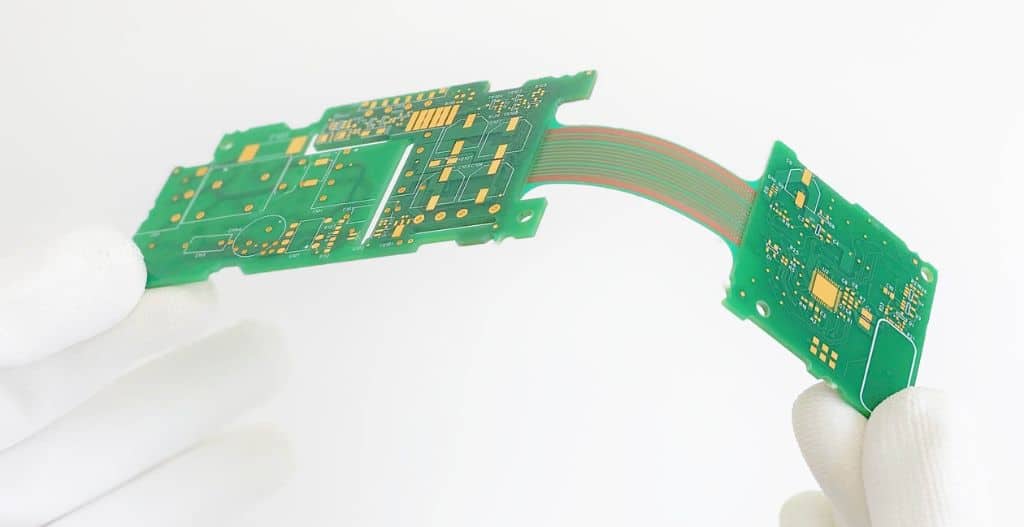What are Semi-Flex PCBs
Printed circuit boards are the foundation of modern electronics. From smartphones to space shuttles, PCBs provide the interconnects between components and enable complex circuit designs. While the most common type of PCB is the rigid PCB, made of rigid FR4 material, some applications require more flexible and bendable PCB substrates. This gave rise to flexible PCBs, also known as flex PCBs, which use thin and bendable materials like polyimide.
However, pure rigid and pure flex PCBs represent two spectrum extremes. Rigid PCBs offer reliability but no flexibility, while flex PCBs provide unlimited flexing but lack structural rigidity. This led to the development of semi-flex PCBs, which bridge the gap between fully rigid and fully flexible PCBs.
Semi-flex PCBs, as the name suggests, offer both partial flexibility and partial rigidity. They can bend and flex to a certain degree, typically 30 to 130 degrees, but cannot be bent repeatedly like pure flex PCBs. The semi-flexibility allows accommodating some movement and vibrations in the end product, while retaining overall structural stability.
Semi-flex printed circuit boards are produced by milling down a section of a standard rigid FR4 board to a thickness between 0.10mm to 0.30mm. This thin region allows the board to be bent once to fit into enclosures used in automotive and data communication products. For applications needing multiple bends over time, fully flexible PCBs capable of repeated bending are available.
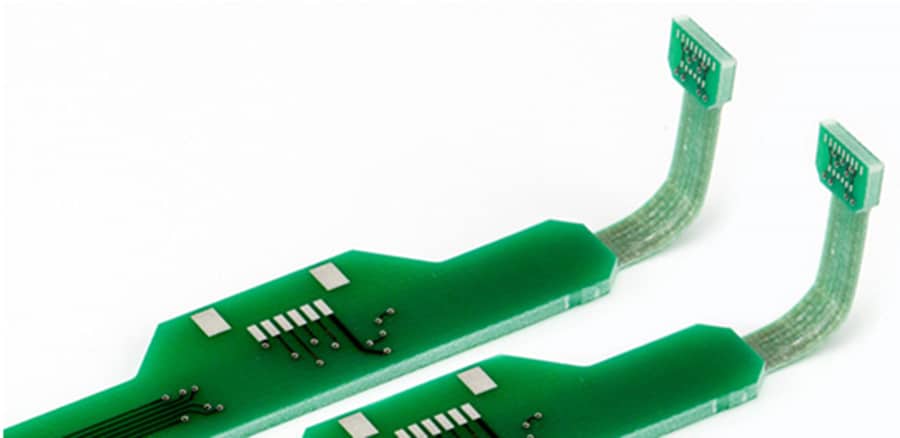
Semi-flex PCBs are usually used for a one-time bend installation.
Table of Contents
Semi-Flex PCB Materials and Structure
Semi-flex PCBs, made entirely with FR-4, the semi-flex PCB is a cost-effective alternative to flex PCBs. Semi-flex PCBs are low-cost, reliable and bendable. The conductor layers are formed by laminating copper foils, usually 1 ounce (35μm) thickness, onto the substrate. Rolled annealed copper or electro-deposited copper foils are commonly used. A solder mask layer is added on top to define soldering areas and prevent bridging. Rigid sections use typical green solder mask.
Semi-flex PCBs can integrate 2 to 8 conductive layers, allowing complex circuit routing like multilayer rigid PCBs. Vias and buried vias can connect between layers. Component pads and traces use standard copper or solder finishes like Immersion Tin, ENIG, or OSP.
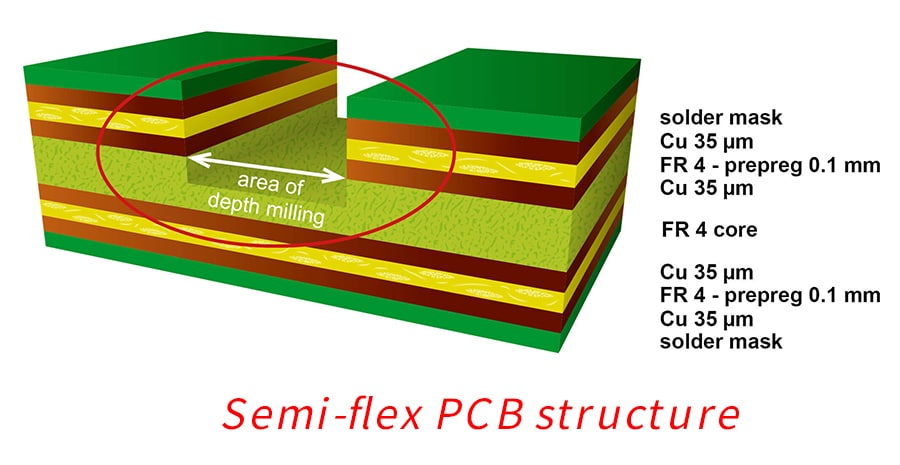
In Semiflex Technology the (semi-) flexible area is produced by defined depth-milling.
Benefits and Advantages of Using Semi-Flex PCBs
Semi-flex PCBs provide a number of benefits compared to regular rigid PCBs or fully flexible PCBs:
- Balanced flex and rigidity – The part-flexible nature of semi-flex PCBs allows them to be bent and flexed moderately while retaining overall structural rigidity. This makes them suitable for applications that require some dynamic movement but also need mechanical stability.
- Reliability – The use of proven FR4 materials in rigid sections ensures the reliability and performance is close to that of full rigid PCBs, superior to pure flex PCBs.
- Higher design freedom – Semi-flex PCBs allow integrating rigid and flex sections in one board, enabling more compact and space-efficient designs.
- Easier assembly – Components can be easily assembled on the rigid portions using standard SMT processes, unlike pure flex PCBs which need special flex component packaging.
- Wide applications – The partial flex nature broadens the applicability of semi-flex PCBs to a wide array of products in consumer electronics, automotive, industrial, medical, and other industries.
- Cost-effectiveness – Semi-flex PCBs can potentially have lower costs compared to rigid-flex solutions with separate rigid and flex boards.
In summary, the adaptable nature and reliability of semi-flex PCB technology make it an attractive option for many applications needing moderate flex and rigidity.

Comparing Semi-Flex PCBs with Rigid, Flex, and Rigid-Flex PCBs
While semi-flex PCBs have hybrid properties, it is useful to distinguish them from pure rigid, pure flex, and rigid-flex PCB technologies:
- Rigid PCBs – Made completely of stiff FR4 material, rigid PCBs have no flex capability. Semi-flex PCBs have some flexible areas, allowing controlled bending.
- Flex PCBs – Using only thin plastic films like polyimide, flex PCBs are completely flexible and bendable. But they lack structural rigidity. Semi-flex PCBs strike a balance with partial rigidity.
- Rigid-flex PCBs combine rigid and flex boards interconnected through a connector. Semi-flex PCBs integrate both rigid and flex in one board.
- Layer count – Rigid PCBs can have up to 30+ layers, flex PCBs about 6 layers, and rigid-flex up to 10+ layers. Semi-flex PCBs typically range from 2 to 8 layers.
- Fabrication – The manufacturing process of semi-flexible PCBs is mostly identical to that of standard rigid PCBs. Like rigid boards, semi-flex PCBs can be fabricated as single-layer, double-layer or multilayer boards. They use the same materials like FR4 and copper traces, except for a special bendable solder mask. The key difference is that at the end of production, targeted bend areas are milled to thin cross-sections by Z-axis routers. This milling leaves enough thickness for the copper traces to bend while removing excess base material. Overall, semi-flex PCB fabrication closely mirrors rigid PCB processes aside from selective final milling of flex zones.
- Applications – Rigid, flex, and rigid-flex PCBs each serve different application needs. Semi-flex PCBs fill the gap for uses requiring moderate bendability.
In summary, semi-flex PCBs occupy a middle ground with their blend of properties. Their complementary characteristics make them suitable for a variety of applications.
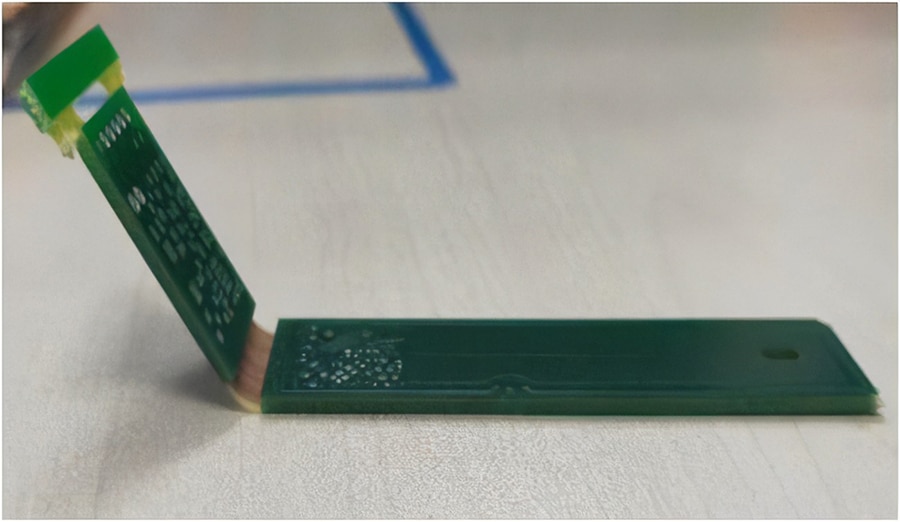
Applications and Use Cases of Semi-Flex PCBs
With their unique combination of flex and rigidity, semi-flex PCBs are utilized across a wide range of industries and applications:
- Consumer Electronics – Semi-flex PCBs are used in wearables, smartphones, laptops and other consumer electronics where some flexibility and bendability is required while still maintaining stability. The boards can flex to accommodate motion, impact and form factors.
- Automotive – In car navigation systems, EV battery packs, parking sensors etc, semi-flex PCBs withstand vibrations while providing reliable interconnects. Their flex allows fitting PCBs into tight spaces.
- Industrial – Semi-flex PCBs are ideal for industrial remote controls, robots, motion control devices that require dynamic movements and reliability. The bendable areas absorb stresses and impacts.
- Medical – In patient monitoring systems, digital imaging equipment and other medical electronics, semi-flex PCBs integrate rigid and flex regions for compact and ergonomic designs.
- Aerospace and Defense – For avionics, guidance systems and space electronics, semi-flex PCBs offer reliability along with some ability to handle shock, vibration and thermal stresses.
With increasing miniaturization and mobility demands, semi-flex PCBs provide the right combination of stability, reliability and flexneeded in a wide range of modern electronic products.
Construction Note Bending:
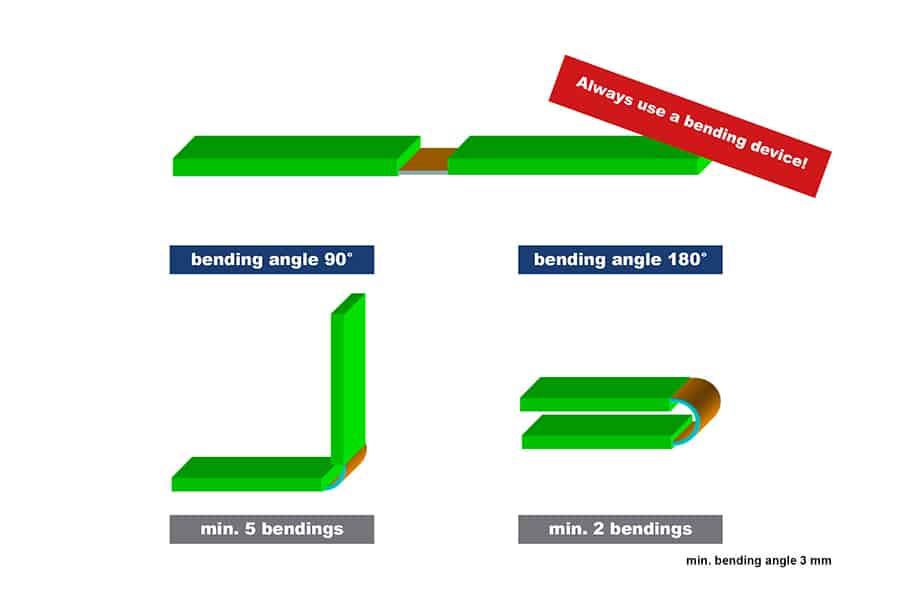

JHYPCB's Capabilities in Manufacturing Semi-Flex PCBs
JHYPCB is a professional PCB manufacturer based in China, with extensive experience in producing rigid, flexible, and rigid-flex PCBs. We also have strong capabilities when it comes to manufacturing semi-flex PCBs.
Our facility is equipped with cutting-edge equipment to fabricate multi-layer PCBs in both rigid and flex configurations. For semi-flex PCBs, we can combine rigid FR4 layers with flexible PI/PET films to produce boards with 2 to 8 conductive layers. Line width, spacing and hole size can be as small as 4/4/0.15mm (6/6/0.2mm on flex layers).
We accept customer Gerber data and can work with you to design an optimal semi-flex stackup based on your specific mechanical and electrical needs. Our Engineering team ensures impedance control, thermal dissipation, and structural stability in the semi-flex PCB design.
JHYPCB is highly experienced in handling different types of high-reliability materials and processes – from lead-free soldering to UL-94 V0 flame retardant grades of FR4 and flexible substrates. We pass rigorous quality testing at every stage of the semi-flex PCB fabrication process.
In addition to bare PCB manufacturing, we also provide complete assembly services, including SMT, thru-hole, press-fit, and mixed technologies. Just ship us your components and we build and test the full product for you.
Contact us today to discuss your requirements for semi-flex PCB fabrication and assembly! Our engineers are ready to partner with you to manufacture high-quality, reliable semi-flex PCBs for your next project.
The Future of Semi-Flex PCB Technology
Semi-flex PCB technology has progressed rapidly in recent years, driven by demands for smaller and more flexible electronics. Some key trends that will shape the future of semi-flex PCBs:
- Higher layer counts – Manufacturing improvements will enable higher layer semi-flex PCBs exceeding 10 layers. This will aid complex circuit and component integration.
- Finer features – Semi-flex PCBs will approach rigid PCB capabilities with line/space width reaching 2/2 mil along with 0.1mm vias. This will enable further miniaturization.
- Advanced materials – New substrate materials like LCP (liquid crystal polymer) will be harnessed for their superior heat resistance and stability. Reliability will also be boosted.
- 3D interconnects – Semi-flex PCBs may integrate folded or curved 3D shapes for uniquely shaped electronics. Additive manufacturing will assist 3D integration.
- Design tools – More sophisticated CAD tools will simplify the design process for complex semi-flex PCBs, allowing faster iteration and prototyping.
- Cost reduction – Manufacturing improvements and economies of scale will continue to lower production costs, making semi-flex PCB solutions more affordable.
- Widening applications – The flexibility and reliability will drive adoption of semi-flex PCBs in diverse cutting-edge applications from wearables and IoT devices to electric vehicles.
In summary, we can expect even more versatile, higher performing, and more cost-effective semi-flex PCB technology playing a key role in the electronics of tomorrow.
Conclusion
Semi-flex PCBs occupy an important middle ground between rigid PCBs and fully flex PCBs. Semi-flex PCBs balance stability and bendability for optimal performance.
Key benefits of semi-flex PCB technology include enhanced reliability compared to pure flex PCBs, higher design freedom, easier assembly, and wide applicability spanning consumer electronics, automotive, industrial, medical and other industries. Their moderate flex properties well suit the demands of miniaturized and movable electronics.
As PCB fabrication techniques advance, semi-flex PCBs will gain even higher layer counts, finer features, advanced materials and improved capabilities. They will continue playing a crucial role in enabling the electronics revolution powering a more connected, mobile and technology-integrated world. With their smart integration of rigid and flexible PCB properties, semi-flex PCBs provide the ideal solution for electronics and products needing both.
Related Reading
- Custom Flex PCB:Tailored Solutions for Your Applications
- Flexible PCB Manufacturing: A Guide to Fabrication and Assembly
- How to Select the Right Flexible PCB Manufacturer for Your Product: A 6-Step Guide
- Layer Stackup in Rigid-Flex PCB
- What Are The Types of Flexible Circuit Boards?
- Flexible PCB Applications
- Why is Flexible PCB so Expensive?
- What Is Flexible PCB Coverlay (FPC Cover Layer)?
- The Manufacturing Process Of Double-sided Flexible PCB Coverlay
- What Are The Advantages And Applications Of Rigid-Flex PCBs?
- Rigid PCB vs Flex PCB: What Is The Difference?
- What Are Flexible PCB Stiffeners?
- How to Solder On Flex PCB?
- Flexible Printed Circuit For Today’s Packaging
- 16 Factors Affecting The Cost And Price of Flexible PCB
- Development and Applications of FPC Flexible PCB
- Complete Introduction of Flexible Circuit Board Materials
- Knowledge of Flexible PCB Manufacturing Process Steps
- Knowledge of Plating on Flexible Circuit Board Surface
- Five factors that FPC PCB designers should know about impedance control
- Key Process Flow of Rigid-Fled PCB Production

